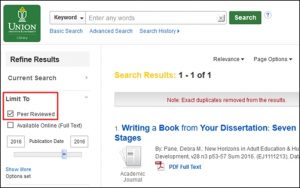The Oxford English Dictionary defines peer review as, “The process by which an academic journal passes a paper submitted for publication to independent experts for comments on its suitability and worth; refereeing.” Peer review a process that protects scholarship by confirming that the research and writing of a scholarly article is valid, original, of high quality, and relevant to the journal to which it has been submitted. Usually articles in a peer reviewed journal have been reviewed by 2-5 independent experts in the field. The most commonly used forms are single and double-blind methods of review, where either the author, or the reviewer, or both, do not know each others identities. That acts as a protection against favoritism.
In journal world, there are basically three types of journals: scholarly (peer reviewed), popular, and trade. Popular journal names include Vogue, Popular Science, Time and Rolling Stone. Trade journals include such names as American Architect, Maritime Journal, and the Progressive Farmer, and are between popular and scholarly. Those two types include heavy advertising specifically aimed at their readership, usually in the profession in question, are written for a general population, and do not usually include notes or bibliographies. They are usually monthly, bi-weekly, or weekly.
 PRJs, on the other hand, are written by credentialed experts in the field, use technical language specific to the subject, and are written for scholars, researchers and students. They are often bi-monthly or quarterly publications, and contain very little (but highly specialized) advertising. Examples of PRJs include Developmental Psychology, Journal of Personality Assessment, Teachers and Teaching: Theory and Practice, and Humor: International Journal of Humor Research. Keep in mind that just because a journal is a PRJ, editorials and book reviews are not necessarily peer reviewed.
PRJs, on the other hand, are written by credentialed experts in the field, use technical language specific to the subject, and are written for scholars, researchers and students. They are often bi-monthly or quarterly publications, and contain very little (but highly specialized) advertising. Examples of PRJs include Developmental Psychology, Journal of Personality Assessment, Teachers and Teaching: Theory and Practice, and Humor: International Journal of Humor Research. Keep in mind that just because a journal is a PRJ, editorials and book reviews are not necessarily peer reviewed.
There are three ways to narrow your searches.
The first method is to narrow your search results by Peer Reviewed in OneSearch or a database that offers that option. Just because the journal is peer reviewed, however, does not mean that everything contained inside is peer reviewed. Editorials, letters to the editor, and book reviews are generally not peer reviewed, so use caution when choosing your resources!
Secondly, use the Publication Search to find information about the journal. The journal’s detailed record page will list varied and useful information about the publication, including whether or not it is peer reviewed.
The third method is to find the official website of the journal that contains an article that you have found (this is an appropriate use of Google), and you should find your answer on the home page. An example of this is the ISHS website, which describes the content, the level of peer review that is adhered to, and offers links to their editorial board and publisher information as well.